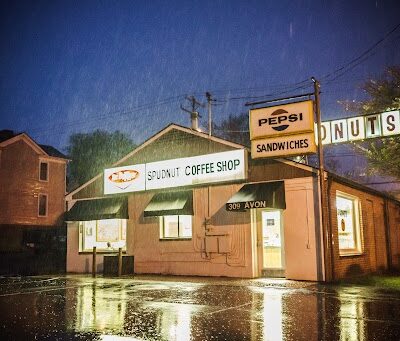People who are buying houses have plenty to think about. There’s the matter of how much to offer and what type of mortgage to take out. There’s the need to get a home inspection and consider whether any problems —leaky roof, sagging porch—are worth asking the sellers to fix before closing. You have to arrange to move from wherever you’re living; you have to get termite, water and septic tests; you have to deal with title companies and insurance companies and interest rates and points. And all this comes after the decisions about who your agent will be and, of course, which property you want to buy.
Almost no one thinks about whether there might be gasoline in the well.
|
Holli and David Traud with their son, 15-month-old Paul, at their home in Keswick. Breastfeeding at the time, Holli was out of town when gasoline components were discovered in their water. “Don’t come home,” David told her and for the next 10 weeks, she didn’t. |
Next time David and Holli Traud buy a house, though, you can bet they’ll be thinking about it. “If I had to buy a home anywhere ever again, that would be written into the contract—a full test of all the water,” David says. As C-VILLE reported on May 19, the Trauds moved into their Keswick house in May 2008—a house that was a year old at the time and had never been occupied—only to discover that their well water had a funny taste and smell. At first, they thought the water was just stale, but after giving it a week or two, they realized it was getting worse instead of better.
A water test revealed an unexpected problem. In mid-June, David says, “[The lab] called me personally and said, ‘We got some disturbing results here—do not drink the water. We have gasoline components.’ At that point my wife was staying in North Carolina, and I called and said ‘Don’t come home.’”
For the next 10 weeks, she didn’t, staying with family instead. At the time, she was breastfeeding their newborn son. Meanwhile, David and his neighbors, David and Irene Mullins—who had noticed a problem with their well, too—were going through a series of tests and visits from the state Department of Environmental Quality. The news wasn’t good. Not only were both wells “severely impacted,” in the words of DEQ geologist Todd Pitsenberger, but the Trauds and Mullins learned that the gas had come from a leaking underground storage tank at a defunct nearby service station, the E&D Market, where a gas leak had been detected as early as 1998. (The station became a veterinary clinic, Old Dominion Equine Association, in 2004.)
It seemed like bad luck of the most infuriating kind. “Considering that we just sunk our entire life savings into this nice beautiful house out in the country, and no one can live there, it was a very bad day,” says David Traud. But the problem of leaking gas tanks is much more widespread than he—and indeed, most people—had realized.
Unseen trouble
“They started putting tanks in the ground back in the ’40s and ’50s,” says Todd Pitsenberger, “and nobody really thought ‘These things are going to leak.’ It was out of sight, out of mind.” But the tanks were made of steel, which quietly rusted over the decades until, in the mid-to-late ‘80s, gasoline contamination started to show up in wells and springs across the U.S.
“The [Environmental Protection Agency] said ‘Holy moly, we’ve got a problem all over our country,’” says Pitsenberger. Through 1984 amendments to the 1976 Resource Conservation and Recovery Act, the EPA developed regulations to make sure that tanks were built with corrosion protection, routinely inspected, and equipped with alarms to indicate leaks. But thousands of older tanks continued to cause trouble.
It was 1998 when the E&D Market was being dismantled and its underground storage tanks (USTs) removed. “In the process they collected soil samples and found some slightly elevated concentrations of hydrocarbons in the soil,” Pitsenberger explains. These results were reported to the DEQ, which then took several soil borings to gauge how bad the problem was. “We believed it was relatively minor,” says Pitsenberger. “There were no wells or springs or other potential receptors right there in the immediate vicinity. We closed the case a year or so later.”
That’s standard procedure, he says. “We look at risk to human health and to the environment; we don’t necessarily consider groundwater a receptor unless it’s being used for consumption.” For example, he says, a leaky tank in Charlottesville, where people rely on municipal water, might not require a cleanup. What does trigger action by DEQ are situations where contaminants enter drinking water, utility lines, basements or streams.
|
The Trauds now have a series of filters in their basement, while they await a new well to be drilled. |
Essentially, the DEQ must perform triage. “In Virginia we do risk-based corrective action,” he explains. “If there is risk to a human receptor or a stream, then we do a lot more work and a lot of corrective action. If there is no risk, we let the contamination naturally attenuate and let Mother Nature take care of it.”
As it happens, because of population density and geological factors, Albemarle County is particularly polluted by USTs. The regional office where Pitsenberger works, which covers 14 counties, has roughly 200 cases at the moment, including 34 in Albemarle. “When it comes to petroleum tank releases,” says Pitsenberger, “Albemarle County’s probably our busiest.” Consider the number of mom-and-pop gas stations and country stores throughout the county, and how the vast majority of those are relatively old, and you can start to grasp the problem. There are active DEQ cases right now at the Crossroads Store (29S and Plank Road), the Hunt Country Store (Garth Road), Toddsbury of Ivy, the Bellair Exxon, and almost two dozen other sites in Albemarle.
That’s not counting the places where there is no currently active DEQ file; in Albemarle alone, Pitsenberger said, “I’m sure we have several hundred sites where this type of thing is happening.”
From a homeowner’s perspective, though, it only takes a single UST leak to turn one’s biggest asset and investment into a liability. “There’s no question there was more contamination [at the E&D Market site] than what we realized,” says Pitsenberger. “And had these wells not been installed it never would have caused a problem.”
Permission granted
Two years before the Trauds’ house was built, in 2005, the Charlottesville Albemarle Health Department issued a permit for their well to Wilbur and Emma Tinsley, who at that time owned the property. Jeff McDaniel, the department’s manager of environmental health, says that the procedure for issuing a permit involves a number of steps, starting with an application on which the property owner must indicate any potential source of contamination.
The health department also performs a site survey and looks at records pertaining to neighboring properties. It even gives handouts to property owners asking them to be on the lookout for nearby USTs.
Somehow, though, no one realized that a documented UST leak had already occurred right next door to what would become the Trauds’ property. “We know the DEQ has a website that we can look at to see if there are any known leaks in the area,” says McDaniel. Online DEQ records do indicate a case at the E&D Market, dated September 1998, which was a closed case at the time the well permit was issued. But health department records contain no indication that the DEQ website was checked.
McDaniel explains that the minimum distance between a well and a UST is 100 feet, but that the health department prefers to leave about 200 feet as a buffer. The Trauds’ well is about 300 feet away from where the E&D UST had been, and the Mullins’ even further.
|
The former site of the E&D Market where the underground petroleum storage tanks that contaminated the Trauds’ water were located. The state has similar active cases right now at the Crossroads Store, the Hunt Country Store, Toddsbury of Ivy, the Bellair Exxon, and almost two dozen other sites in Albemarle. |
“I honestly think there’s a significant flaw in the system that allows a county health department to issue a well permit within 100 meters of a known petroleum release,” says David Traud. “The left hand didn’t know what the right hand was doing…That’s unacceptable. Because that system wasn’t in place to see that these things were checked, we’re going to lose.”
They have already lost. During the 10 weeks that Holli and their son lived in North Carolina, David stayed with army buddies and traveled to see his family as often as he could. Now, a year after buying the house, they still can’t drink from their faucets. A filtration system installed by the DEQ makes the water usable for washing, but Traud fills gallon jugs at work for drinking. “It’s been a very, very hard year for us,” he says.
Besides the inconvenience and the expenses they have borne—a water test, a lead test for their son (which was negative), lots of bottled water, and a ruined $3,000 water softener—there is the sheer disappointment of having saved up for a home that, beneath a clean, white-picket-fence appearance, turned out to be so potentially unhealthy. Before they bought the house, which cost $400,000, they were living in Germany, where David served in the Army and Holli worked for the State Department.
“We socked away all our extra cash in Germany thinking when we got back we could really get a nice place,” David remembers. “We wanted to live out in the country. We had high hopes.”
The cleanup
At this point, they’ll be relieved just to be able to give their son a drink of water without fearing for his health. Working with a private consulting company, Vista Environmental, the DEQ has issued a Corrective Action Plan calling for new wells to be drilled at the Traud and Mullins houses in early- to mid-July, then monitored for a year. The $81,000 cost of remediation will be the responsibility of the owners of the former gas station, who in turn will be eligible for assistance through the DEQ-operated Virginia Petroleum Storage Tank Fund (VPSTF).
Home fires burningUnderground gas tanks aren’t the only ones that leak. An even more widespread problem occurs with residential heating oil tanks. “They leak just the same as the big gas tanks,” says the DEQ’s Todd Pitsenberger. “Lots of folks in Albemarle County own homes built in the ‘60s and ‘70s, and the tanks were put in at that time. They’re leaking as we speak. We deal with hundreds of those every year.” John Pollard of Pollard Environmental says that of the USTs his company has tested, 90 percent were installed before 1980, and of those, more than 60 percent had leaks. Thirty years is the general life expectancy of home tanks. Unlike with commercial gas stations, home heating oil tanks are not required to have corrosion protection, inspections, or alarms to indicate leaks. Homeowners are just supposed to monitor them on their own; if a problem comes up, the Virginia Petroleum Storage Tank Fund (VPSTF) can help with corrective action expenses over $500. Most heating-oil cases ultimately cost less than $5,000, Pollard says, though “You do get some severe ones.” Call the regional office of the DEQ at (540) 574-7800 if you suspect you may have a leaking tank. Close communication with the DEQ is important to be able to take advantage of the VPSTF—in fact, regulations require that UST leaks be reported to DEQ within 24 hours of their discovery.—E.H. |
John Pollard, whose Richmond-based cleanup business, Pollard Environmental, has been operating for 10 years, handles 300-400 cases of leaking USTs per year statewide. (Five to 10 percent of those involve gasoline tanks; the rest involve home heating-oil tanks. See sidebar.)
When a company like Pollard determines a tank is leaking, there is a range of ways to deal with the problem, from simply stopping the leak, to drilling a new well, to excavating contaminated soil and attempting to clean up groundwater. How do you get petroleum out of groundwater? “Well, it’s pretty difficult,” says Pollard. “If there’s a lot of oil in the groundwater, there are some things we can do to recover some of it. Rarely will you be able to get all of it out. In fact I’d say never.” Techniques include drilling special wells to act as openings through which some petroleum can be pumped out; this can take, according to Pollard, six months or several decades.
As for soil excavation, again, it’s a matter of damage control. “The idea is not to excavate all the contaminated soils,” Pollard says. “The idea is to get a hot spot out, and then let nature take care of the residual levels.” Saturated soil—hundreds of tons in some gas tank cases—is taken to a treatment facility where it’s either bioremediated (treated with microbes) or has its hydrocarbons burned off.
Pollard says much of his business comes from people who are buying or selling real estate and want to make sure they don’t end up in a pickle like the Trauds’. Sometimes, abandoned gas tanks are on a property under contract—especially old farms, where gas tanks were often buried to service tractors and other equipment. “If it’s an old farm and you’re going to rely on the groundwater for drinking, it’s worth asking questions about old petroleum storage tanks,” he says. “Similarly, if it’s an area that used to be industrial or had a gas station nearby, a little bit of due diligence can go a long way.”
Given that when the Trauds first saw their property, there was no visual evidence that a gas station had ever existed next door, the DEQ records of the 1998 E&D case would seem to be the only clear signal to them that a UST leak was even a possibility. And Marjorie Adam, a Charlottesville-based realtor for 14 years, says that leaking gas tanks—particularly those off-site—are not usually on anyone’s mind during a property transaction.
“The standard that’s been very accepted is the termite, well, septic,” she says. “[With the] well, they do a sample for bacteria. If it’s too high, they chlorinate the well.” The Trauds ordered a standard water test before buying, but chemical contaminants are not detected in standard tests. “It never occurred to us to have a benzene test,” says David Traud. Tests for gasoline components are only handled by a few labs and cost roughly $85-100.
It’s an open question whether the leak will impact the Trauds’ property value should they decide to sell in the future. “I have a great degree of confidence that it will be fixed,” says Traud, “but who wants to buy a house within yards [of a gasoline leak]?”
According to Adam, if any problem with a given property has been fixed, the matter is considered closed. “I would think in the end property value wouldn’t be affected if it’s remedied,” she says—particularly with documentation from the DEQ. But, she adds, “That doesn’t mean I’m saying hide it.”
In other words, she would advise sellers to disclose the problem and the remediation during a transaction. And that, she says, may spook some buyers. “How is it going to affect the buyer? Some won’t touch it with a 10 foot pole. Some won’t care. It’s going to depend on the person.”
If nothing else, it would be an opportunity for education. Speaking of the public in general, Pitsenberger says, “It’s shocking that they aren’t more aware of [this problem].”
C-VILLE welcomes news tips from readers. Send them to news@c-ville.com.








